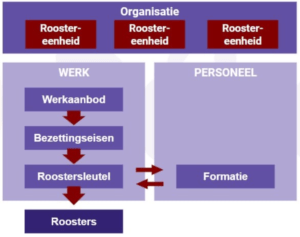
Author: Dehora
The term big data probably sounds familiar to many people. After all, much is written and spoken about in the media and perhaps also in your organization. But what exactly it is, few people can give a clear and unambiguous answer to that. Also because the term is often used in many different ways. A good definition of big data is: a large set of data that needs to be analyzed mathematically to reflect patterns, trends and connections (especially in relation to human behavior). The latter, the patterns, trends and connections in relation to human behavior, makes big data increasingly relevant in the field of personnel planning or workforce planning in recent years.
A good roadmap is crucial in the development of healthy schedules
Workforce planning often involves large amounts of data, or big data, about business processes, services, employees and the workload. However, these data are often not well analyzed and used, making suboptimal choices during the planning process. These choices can have major consequences for the (results of the) organization. A good step-by-step plan for achieving healthy schedules is therefore crucial.

Roster design process as a step-by-step plan to a healthy schedule
First of all, Déhora’s experts advise to make a work-offer analysis with data that are available internally. This analysis provides a clear picture of the work to be performed and the workload. Once the work offer has been made transparent, net occupancy requirements can be set for this, stating how many employees must be present at least at the time of the day. Then, in combination with the available and / or desired formation, a gross schedule key can be set up. Using the gross timetable key, grids can be created that actually match the workload.
Now many organizations appear to base new schedules on the current start and end times from the current schedules and on grid patterns and hours that employees are accustomed to. But in this way the times at which the work actually takes place are not included, the amount of work and the expected deviations. A thorough work supply analysis plays a crucial role in this. This turns out to be quite a difficult task in practice. For example, in many organizations, due to the intensive involvement in the business process and limited plan education, there is a lack of well-trained plan professionals with a helicopter view who can carry out this analysis.
Sharpening the wind
The analysis and translation of big data is often complex in practice, which is partly due to the lack of data analysts within organizations. Organizations can suffer many consequences from this, such as low satisfaction of the staff and the customer and it also has an effect on the business results of the organization. If people work at times when they are not needed or need to work extra if there are shortages, this works demotivating and can lead to unnecessary absenteeism. If the organization starts to sail more sharply, by using the right number of employees at the right time - in accordance with the job offer - this will immediately have a positive influence on employee satisfaction and company results. Good data analysis plays a crucial role in this.
If you would like to see ICRON in action, please contact us. If you have enjoyed this blog, you can find more content that you might enjoy here.













